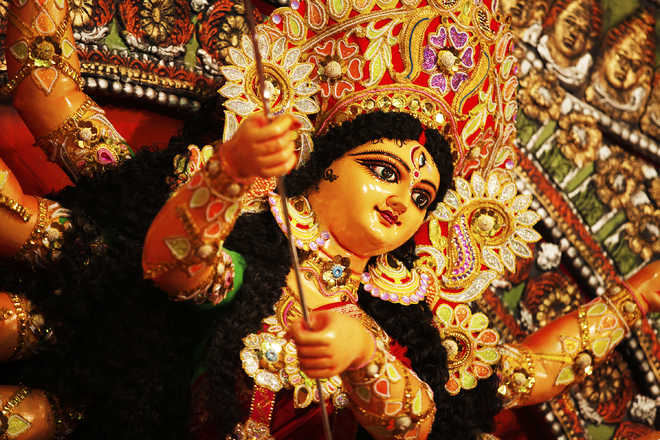Worship of Shakti
Dr Satish K Kapoor
‘Who are you, O Great goddess?’
‘...I am the manifestation of Brahman;
From me the world arises,
As Nature and as the Self.’
— Devi Upanishad
The worship of Shakti can be traced to the Rigveda as evidenced by the Devi Sukta, Ratri Sukta, and Shri Sukta, and invocation to goddesses like Sarasvati, Usha, and Aditi, among others. She is said to represent prakriti, the counterpart of purusha. In her supreme aspect, she is neither male nor female nor neuter. But she takes up a corporeal form to curb evil and restore justice.
Symbolic presentation of deities in the Rigveda acquired an anthropomorphic form in the post-Vedic period. Each family came to have a kula-devi or devata, and each village, a grama devi or devata, or both, to seek blessings, and to ward off evil or natural calamities. Since the word ‘mother’ evokes feelings of selfless love and affection, the shrines of mother goddesses like Amma, Amba, Uma or Parvati, became popular.
Saptamatrikas or seven divine mothers, namely Brahmi, Maheshvari, Kaumari, Vaishnavi, Varahi, Mahendri and Chamunda were propitiated as aspects of Durga, who was invoked by Yudhishthira, eldest of Pandava brothers, before spending the last year of exile incognito in Matasya desha, and by Arjuna to win the battle of the Mahabharata.
‘You are called Durga by all
Because you save men from difficulty...
You are the soul refuge of men.’
— The Mahabharata, virataparvan
Shakti has become popular under several names such as Kali (black one), Mahakali (mighty Kali), Karali (causing fear), Kapali (who wears human skulls), Chandi (stubborn), Bhavani (who enthuses valour), and Mahishasurmardini, each name depicting her role in exterminating demonic forces and restoring order.
Her Mahishasura-mardini-form was made up of the combined power of the three gods — Brahma, Vishnu and Shiva, to annihilate the buffalo-demon, Mahishasura. As Kali she killed Chanda and Munda, demons, and came to be called, Chamunda. She also killed Raktabija and other demons. Religious scholars read metaphysical meaning into the extermination of demons who embody negative energy which is dispelled by the divine mother’s grace. In esoteric practices, Durga is the presiding deity of vishuddha chakra, within the sushumna channel at the base of throat.
The Devi Mahatmya (also called Chandi or Durga Saptashati), a part of the Markandeya Purana (cantos LXXXI-XCIII), describes the Mother goddess in her three major forms: Mahakali, Mahalakshmi and Mahasarasvati, embodying respectively, the qualities of tamas, inertia, rajas, energy, and sattva, quiescence.
These forms manifest in Nava-Durga, goddess with nine appellations worshipped over nine days during Navaratra (Navaratri) festivals in spring (Vasanta) and autumn (Sharada). These are: Shailaputri (‘daughter of mountain’), Brahmacharini (‘celibate’), Chandraghanta (‘who wears the crescent on her forehead, resembling a bell - ghanta’), Kushmanda (‘who of her own volition, creates the “little cosmic egg” called the universe’), Skandamata (‘mother of Skanda’), Katyayini (daughter of sage Katyayana), Kalaratri (‘dark-complexioned like night’), Maha-Gauri (‘the great Gauri’) and Siddhi-dhatri (‘bestower of boons’).
During Navaratra, each of her forms is propitiated, one after another, by devotees at home or in temples, who observe fast or vigils, do kumari-puja, ‘virgin-adoration’, recite mantra-s, or worship yantra-s geometrical representations, appropriate to the deity. At places, group idols of the goddess are made of straw, bamboo or cow dung, and immersed in running water along with barley plants which are sown on the first day of the lunar fortnight of Ashvina. In some parts of south India, a kalasha, pitcher, made of copper, clay or silver, is covered with a coconut and nine types of leaves before being consecrated to the deity.
The Saundarya Lahiri (verse 1) attributed to Adi Shankaracharya says that Shiva and Shakti are one and the same but without Shakti, Shiva becomes shava, a corpse. Obviously, it is a metaphysical explanation of the masculine and the feminine aspects of the Absolute Being who is one without a second. If Shiva is satya, truth, she is sati (truth in action); if he is brahma, the Supreme, she is brahma-mayi, imbued with his powers; if he is chit, consciousness, she is chiti, consciousness with energy; if he is prakasha, light, she is vimarsha, illumination; if he is ananda, bliss, she is ananda-lahiri, the blissful wave; if he is Kameshvara, god of desire, she is Kameshvari, its fulfilment. Shiva and Shakti are indistinguishable like the sun and its rays or the moon and moonshine.
Navaratra is a special time of the year to invoke and worship Shakti, the divine mother, for self rejuvenation.
(Dr Satish K Kapoor, former British Council Scholar, is a noted educationist, historian and spiritualist based in Jalandhar city.)










